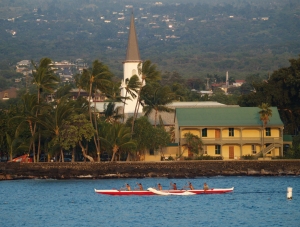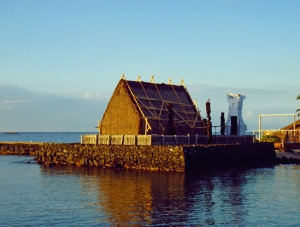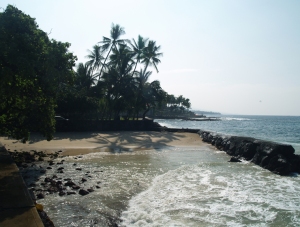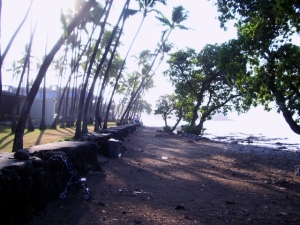Whether you visit the Big Island for a few days, a couple weeks or a few months, you want to make the most of your time in Paradise. With such a wide variety of natural and commercial attractions, it is natural for the visitor to get a little overwhelmed in the “Option Overload” and not be able to make a balanced and informed decision on what they want to do and how best to spend their time.
Choosing which beach you want to spend time on, or where you want to hike or drive can be an exercise in confusion and conflicting advice. Even more so, finding quality information on the history, culture, geology and natural history of the area can be almost impossible--and much of what you do find is inaccurate, or third-hand retellings that are, well, better stories than histories. Clearly, visitors to Hawaii could use help making quality decisions about how best to spend their time and understanding what they are seeing, the culture they are visiting.
This is why Tour Guide Hawaii is so excited and proud to announce the release of their new GPS/WiFi enabled App for iPhone and iPod video tour that helps you navigate your trip to Hawaii with hours of informative, location-aware video and information. Although our video guide will lead you to dozens of unusual, untamed and unspoiled spots, as an example of the fabulous coverage our App for iPhone and iPod provides, let's look at a fascinating, but perhaps mundane-appearing couple of places in the heart of Old Kailua Town itself, but might not be able to find from maps and guidebooks and would otherwise miss if you did not have Tour Guide Hawaii's new App.
Kamakahonu Rock, Kailua Pier and Sea Wall
In the heart of Old Kailua Town's downtown section, amidst the many shops and restaurants, lies the old Kailua Pier and Seawall. As they excitedly trek from the pre-contact Hawaiian temple at Ahu'ena Heiau, to Hulihe'e the Hawaii Royal Palace and Moku'aikaua, the first Christian Church in the state of Hawaii, tourists busy shopping, dining and snapping photos often do not even notice these historic constructions. But the pier and the seawall have an ancient, complex and fascinating history, the stones recycled from gun-turreted forts and ancient Hawaiian royal palace walls over the centuries.
Congregationalist missionaries from Boston crossed the Atlantic Ocean, fought the frigid, turbulent waters off Cape Horn, endured 5 months of intense stormy weather and unimaginably cramped and filthy quarters below decks on the Brig Thaddeus, and headed for a new life in Hawai’i. In March of 1820, the missionaries sailed into the balmy waters of Kailua Bay and landed at Kamakahonu Rock, the “Plymouth Rock” of Hawai’i, in 1820.
First constructed in 1900 and then rebuilt in 1950, stones for the pier and the seawall that runs from the pier to the Old Kona Inn were scavenged from the immense stonewall that once surrounded the Ahu’ena Heiau Temple complex and from the massive stone fort erected after the destruction of the heiau during the reign of Kamehameha II. The large stone fort once boasted a dozen 18-inch naval cannon and was nick-named “The Rock” by passing whalers; today, that appellation is universally applied by locals to the entirety of the Big Island.
The pier originally was built to facilitate loading cattle onto steam freighters bound for Honolulu. Before the advent of the pier, horseback cowboys used to rope and drag individual steers from Kaiakeakua Beach (the miniscule beach just south of the pier), plunge them into the surf and swim them out to waiting whaleboats. There, the cows were lashed to the gunwales of the whaleboat and, with their backs awash, ferried farther out to the steamer offshore. The cows were then, unceremoniously, by means of sling and crane hoisted aboard the steamer
The pier sat on Kamakahonu rock and pilings until 1950 when concrete pylons were poured. From around the turn of the last century until the 1970’s the pier was covered by various sheds and warehouses that served to protect 100 pound coffee bags, sugar and other goods ready for shipment. Renovators in the early 1950s even planted trees along the pier in an effort to beautify the downtown area. The modern shape and configuration of the pier resulted from a year and a half’s renovations during 2003-2004.
Back in the day, at the entrance to the pier sat H. Hackfield And Company, the largest business concern in Kona at the turn of the last century; in 1917, H. Hackfield was bought by American Factors which became AmFac in 1960. Hackfield’s buildings contained a general store, post office, coffee mill and an ice factory as well as serving as the company’s headquarters. Standard Oil stock tanks sat on the shore of Kamakahonu Beach in the 1950s and 1960s until the construction of the original Hotel King Kamehameha in the 1960s. This original hotel was rebuilt as the current King Kamehameha Beach Resort in the 1970s.
In several places along the seawall, if you look 20-60 feet offshore, you will observe the distinct “boil” associated with undersea fresh water springs discharging into the ocean. These springs result from the discharge of aquifers that collect fresh water far up the mountain slopes and transport it down to where they intersect the seafloor. The Hawai’ians used to dive under the surface of the ocean with a sealed gourd, down to the springs, turn the gourd mouth-end down, uncork it and fill the gourd with fresh water. This was a necessary task to obtain fresh water, as fresh water springs are scarce in the Kona district. Today, one can often spot honu (sea turtles) languorously swimming through the springs, trying to kill parasites and algae that grow on their shells and skin.
Today, Kamakahonu Rock (eye of the turtle) lies underneath the modern-day Kailua Pier, where it serves as a footing for it. It is not uncommon to observe dolphin, sea turtles and whale off the pier.
Even many locals will be surprised to learn that the tiny beach adjacent to, and south of, the pier and the little beach associated with Hulihe’e Palace both have names; respectively they are Kaiakeakua (the god of the sea) and Niumalu (“in the shade of the coconut trees”) Beaches. Snorkeling from Kamakahonu, Kaiakeakua or Niumalu beaches is spectacular and strangely uncommon. A beautiful coral garden and abundant fish are to be seen snorkeling along the shoreline of Ahu’ena Heiau and fish, turtles, moray eels and the occasional sunken boat are abundant in Kailua Bay. Be wary of boat traffic to and from the pier, don’t go in on boat days, when careless lighter pilots ignore the marked swim channels.
Many commercial ocean-going enterprises use the Kailua Pier as their departure point, lighters from large cruise ships land here and fishing captains on charter boats still bring their catches of marlin and tuna to be weighed at the scale at the pier. During the 2nd or 3rd weekend of October, the Kailua Pier serves as the staging grounds for the first leg and finish line of the Ironman World Championship Triathlon.
Good fishing is to be had all along the pier and the seawall, but the best is behind the Hulihe'e Palace and the Old Kona Inn. During heavy seas and big storms, waves up to 20 feet high explode over the seawall and surge across Ali’i drive.
Views from the pier are spectacular, particularly at sunset; it is worth the time to stop, explore the pier and the adjacent Ahu’ena Heiau.
Facilities include showers, restrooms, changing rooms, drinking water, public telephones and a boat ramp; Kailua Pier and seawall lie in the heart of Old Kailua Town's many shops and restaurants so anything the visitor could wish for is in easy walking distance.
To see the new iPhone/iPod Touch App, please visit http://www.tourguidehawaii.com/iphone.html. The best of Tour Guide Hawaii's free content about traveling to, and exploring, the Big island, can be found here. For more information on traveling to Hawaii in general and on touring the Big Island in particular, please also visit www.tourguidehawaii.com and www.tourguidehawaii.blogspot.com.
Copyright 2009 by Donald B. MacGowan. All rights reserved.


















No comments:
Post a Comment